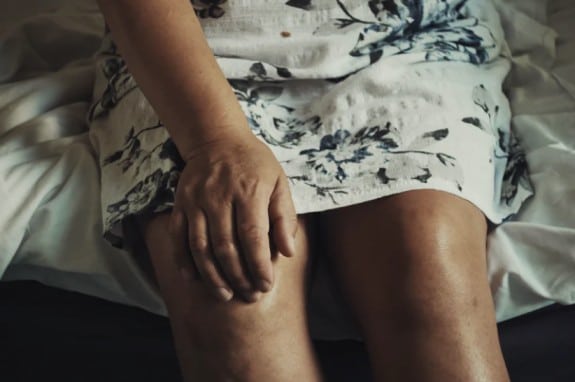Arthritis on the Rise

 According to the CDC, arthritis affects nearly 59 million US adults. That is about 1 in 4 adults. This is an increase of about 4 million people or about 8.5% from 10 years ago. Research finds that arthritis susceptibility increases with age, body mass index, physical inactivity, and worsening physical and mental health. Arthritis is highest among adults who are unable to work, disabled or have fair or poor self-rated health.
There is no cure for arthritis. It is a debilitating disease that progressively gets worse - especially if left untreated. Recent studies have found that alarmingly some common arthritis medical treatments may actually accelerate the disease's progression. Corticosteroid injections, which are commonly used to treat pain associated with knee and back osteoarthritis, may actually contribute to the progression of the disease. The same is true with NSAID pain medications. These medicines mask the pain rather than help repair damaged joints. Furthermore, these medications can lead to ulcers, and stomach, kidney, and liver problems.
According to the CDC, arthritis affects nearly 59 million US adults. That is about 1 in 4 adults. This is an increase of about 4 million people or about 8.5% from 10 years ago. Research finds that arthritis susceptibility increases with age, body mass index, physical inactivity, and worsening physical and mental health. Arthritis is highest among adults who are unable to work, disabled or have fair or poor self-rated health.
There is no cure for arthritis. It is a debilitating disease that progressively gets worse - especially if left untreated. Recent studies have found that alarmingly some common arthritis medical treatments may actually accelerate the disease's progression. Corticosteroid injections, which are commonly used to treat pain associated with knee and back osteoarthritis, may actually contribute to the progression of the disease. The same is true with NSAID pain medications. These medicines mask the pain rather than help repair damaged joints. Furthermore, these medications can lead to ulcers, and stomach, kidney, and liver problems.
There are different alternative treatments that can help slow down the progression of arthritis. These include lifestyle changes, supplements, and exercises. Treatment for arthritis aims to slow the condition's progress and minimize joint inflammation.
We have come up with recommendations to help treat the physical arthritic conditions. Following these steps has helped many people reverse pain from this disease.Get Active!
Physical activity helps arthritis pain. Nearly a third of adults with arthritis are physically inactive. Yet a CDC study shows that severe joint pain is more common among adults with arthritis who are physically inactive. One of the main proven treatments to slow or even reverse arthritis is exercise and physical therapy. It’s safe and effective when done properly and under the supervision of a physical therapist. Exercise can build up your strength to help you better control and manage your joint or muscle pain.
Gentle aerobic exercises, such as walking, swimming, or yoga, can be beneficial in alleviating pain and building up your muscle strength. Exercise helps deliver oxygen to your joints, brain, and muscles and has the added advantage of making you feel good, too.Calm Mind Equals Calm Body
Certain psychotherapy techniques may help you ease anxiety, reduce emotional distress, and get better sleep, which may help you cope with pain:- Biofeedback. You can learn to control your body’s responses to pain triggers. In biofeedback, through sensors connected to your body, a machine will show how thoughts and actions can affect your autonomic nervous system. This controls the heart, lungs, stomach, and intestines, as well as the release of stress hormones. Learning how to control breathing and heart rate will allow you to control other physical reactions, such as pain.
- Cognitive Behavioral Therapy (CBT). In CBT, a psychotherapist helps you identify problematic behaviors, negative thoughts, and feelings. This can increase your awareness of how problematic patterns develop and help you understand the connection between thought patterns and feelings. You are then taught pain-coping skills, such as relaxation techniques, guided imagery, and goal setting, encouraging you to have an active role in managing and controlling pain. CBT can increase your ability to control pain while acknowledging that there may be occasionally flares beyond your control.
Joint Supplements
Joint supplements can help to increase joint mobility, reduce inflammation, support cartilage repair, decrease stiffness, and stimulate lubricating fluids in the joints. Flexcin has powerful ingredients like cetyl myristoleate (CM8) and more traditional anti-inflammation ingredients like glucosamine, MSM, bromelain, and Collagen, Flexcin is an effective supplement that may help with mobility, and inflammation, and prevent further joint degeneration. Flexcin Motion Lotion is a topical cream that may be safely used to provide relief for symptoms of arthritis due to joint pain. At Flexcin we have been making all-natural joint care supplements since the year 2000, and have helped thousands of people find an alternative relief to their joint issues. We provide US-made supplements with powerful ingredients used as alternatives to decreasing swelling and rebuilding damaged tissue. And, we offer it at a no-risk 90-day trial. If you try Flexcin and are unsatisfied with the results after taking it for three months, simply return the empty bottles for a full refund less handling.